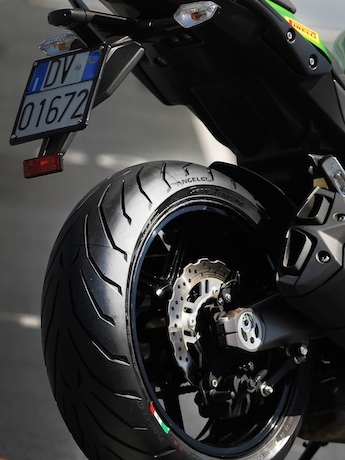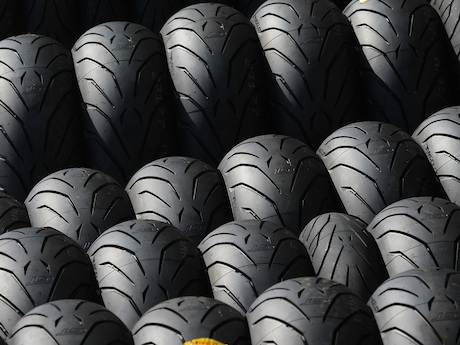Do you know how to break in new motorcycle tyres that come with a glossy and slippery surface? They deserve to be treated with respect and caution.
I once had an embarrassing spill on new tyres right out in front of the dealer when I took charge of a test bike.
Usually test bikes are run in and some manufacturers even get racers to take them to the track for a few laps! But not on this occasion.
It seems strange that new tyres have a glossy surface, but there may be a few reasons for this.
Manufacturers used to use a slippery chemical called a mould release agent to get the rubber tyres to release cleanly from the mould. However, modern moulds have teflon coatings that obviate the need for a release agent.
Even if they don’t use a release agent, tyre manufacturers use chemicals in the curing process to make the rubber flow better and reduce defects in the surface and tread pattern. This results in slick or glossy surfaces, which applies to both motorcycle and car tyres (see a list of top car tyres in RatedRadarDetector).

Apparently riders also like to see a new tyre looking glossy in the showroom, even though they can be slippery. So even if a tyre manufacturer like Dunlop, Continental or Pirelli don’t use a release agent, they still make their tyres look glossy for consumer appeal.
So how do you break them in and get rid of the slippery gloss? Well, some tyre fitters use sanders to scuff up the surface or wash them with an acetone solution to neutralise the oily release agent or wipe them with a cloth to get rid of any slippery fitting lubricant they may have spilt on the tyre surface.
But tyre manufacturers do not recommend washing or sanding your tyres. They go to great lengths to design and engineer tyre treads, so the last thing you should do is attack the tread surface with a belt sander! It is also a bit risky using any chemical solution on a tyre as you do not know if it will be applied evenly and how it will react with the tyre. A wipe with a dry cloth is fine. Notice that race bikes leave the pits with shiny new tyres that have not been belt-sanded or washed with any chemicals.
The best way to break in a tyre, lose that gloss and become sticky is to heat it up and the most effective way to heat a tyre is over a long-distance high-speed highway ride. Racers don’t have that luxury, so they use tyre warmers which they apply about an hour before a race to warm the tyre slowly and evenly.
Most riders seem to think that weaving around on the road like racers on a warm-up lap is the best way to “scuff-up” the tread. However, that is very risky as you could slip over on the glossy surface. Remember, racers are weaving around to keep the heat in the tyre after it has already been warmed up in the garage.

Since most riders don’t have access to tyre warmers, tyre manufacturers suggest a long ride of up to 160-200km to heat the tyres, depending on ambient temperatures. Despite the fact that most racers weave around on warmed-up tyres, you actually don’t need to lean the bike over on to the new and glossy surface to heat up that part of the tyre. Acceleration and braking is more effective as it puts stress on the tyre carcass which heats up the whole tyre, not just the bit touching the road. But again, you should get the tyre hot before any abrupt throttle or brake application.
Don’t think in terms of “scrubbing in” your tyres, but think about heating them up. The distance required to get sufficient heat into them can be dependant on the type of bike, the ambient temperature, the temperature of the road and the road surface.
Before you can start to push the lean limits, get off your bike and feel the tyre temperature with your hand. If it’s hot, you can gradually increase acceleration and braking to get it really hot. Then you should be right to start leaning it over.
Sounds over-cautious? You betcha! You don’t want to be embarrassed, injured, or left with a damaged bike like I did.


